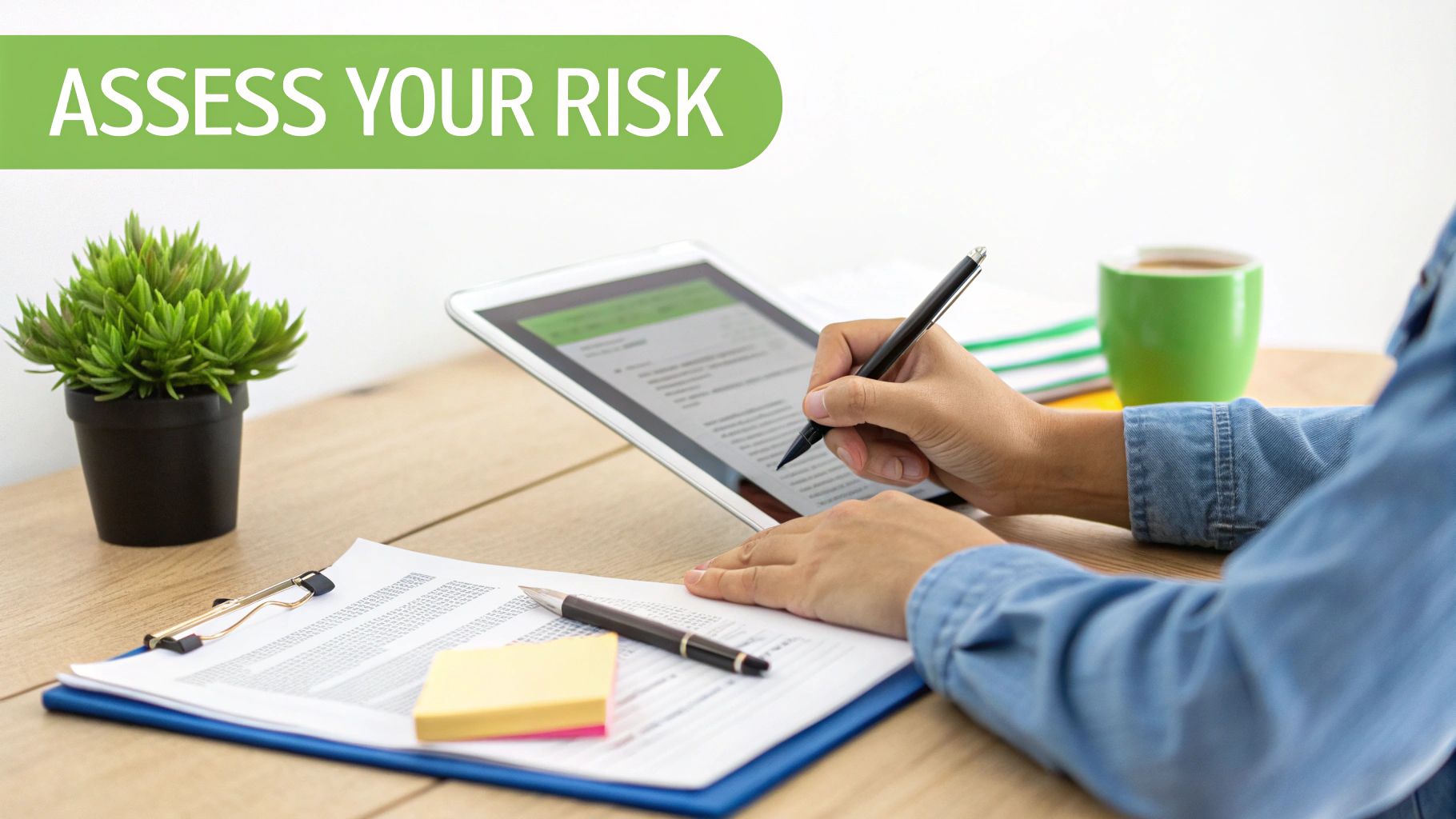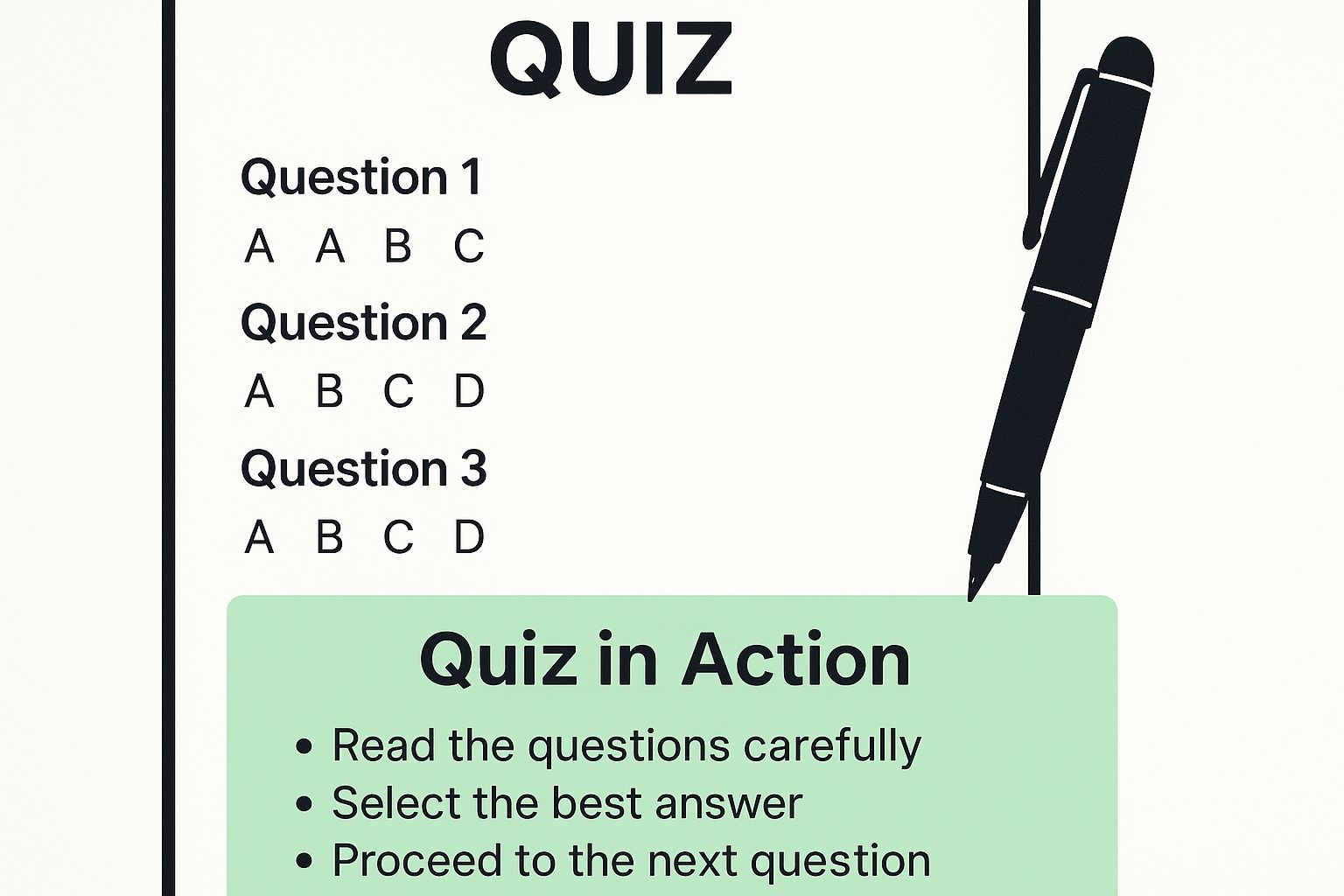Discover Your Investment Risk Tolerance Quiz | Find Your Strategy
If a stock moves past your strike, the option can be assigned — meaning you'll have to sell (in a call) or buy (in a put). Knowing the assignment probability ahead of time is key to managing risk.
Posted by
Related reading
A Trader's Guide to Extrinsic Value Option Profits
Unlock the power of the extrinsic value option. Learn what drives it, how to calculate it, and strategies to profit from time decay and volatility.
A Trader's Guide to the Poor Man Covered Call
Discover the poor man covered call, a capital-efficient options strategy for generating income. Learn how to set it up, manage it, and avoid common mistakes.
A Trader's Guide to Shorting a Put Option
Discover the strategy of shorting a put option. Our guide explains the mechanics, risks, and rewards of cash-secured vs. naked puts with clear examples.
Before you even think about selling your first option, you need to have an honest conversation with yourself about risk. This is where an investment risk tolerance quiz comes in. It's a simple but incredibly important tool that helps you figure out how much market chaos you can actually handle, both emotionally and financially.
Getting this right prevents you from making panicked decisions when the market inevitably gets choppy. It's the real starting point for any sustainable, long-term strategy.
Why Your Investment Journey Starts with a Risk Quiz

Seriously, don't skip this. Especially in options selling where risk management is everything, a quiz isn't just a box to check—it's the foundation of your entire game plan. Think of it as mapping out your financial DNA.
These assessments are designed to uncover the real you, not the high-flying investor you think you should be. The goal is to build a strategy you can stick with when things get messy, not just one that looks good on paper during a bull run.
Defining Your Investor Profile
The main job of a risk quiz is to slot you into an investor profile. Financial firms use a spectrum to classify people based on how much volatility they're willing to stomach in exchange for potential gains. For example, it's common to see risk tolerance broken down into five main levels:
- Conservative: Your top priority is protecting your capital. Full stop.
- Moderately Conservative: You'll accept a little bit of risk for a shot at modest returns.
- Moderate: You're looking for a solid balance between growing your money and keeping it safe.
- Moderately Aggressive: You're comfortable taking on significant risk for the chance at higher returns.
- Aggressive: You’re aiming for maximum growth and understand that could come with substantial losses.
Understanding these profiles is a huge first step. You can see how these risk classifications are defined and how they form the bedrock of a strategy that won't fall apart when the market gets shaky.
A classic mistake is thinking you're a daredevil investor during a bull market. Your true risk tolerance doesn't show up when your account is green—it's revealed when you're staring at a sea of red.
A Quick Look at Investor Risk Profiles
Here’s a snapshot of common investor profiles and what they mean for your investment approach.
| Risk Profile | Primary Investor Goal | Typical Asset Focus |
|---|---|---|
| Conservative | Capital Preservation | Fixed income, cash equivalents, low-volatility ETFs |
| Moderate | Balanced Growth & Security | Mix of blue-chip stocks, bonds, and diversified funds |
| Aggressive | Maximum Growth | Growth stocks, options, alternative investments |
This table just scratches the surface, but it gives you a clear idea of how your profile directly influences where your money should (and shouldn't) go.
Ultimately, knowing whether you're conservative, aggressive, or somewhere in the middle is what guides every single trade you make. It ensures your strategy is built on self-awareness, not just a reaction to the latest market hype.
How to Get Honest Answers from Your Risk Quiz
Taking an investment risk tolerance quiz is the easy part. Answering it honestly? That’s where the real work begins.
To get a true picture of your financial DNA, you have to tune out the noise. That means ignoring the recent market hype (or panic) and confronting your own biases head-on. It’s all too common to feel like a genius in a bull market and overestimate your nerve, only to become overly timid after a dip. The goal is to answer from a neutral, clear-headed space.
Willingness vs. Ability to Take Risk
Here’s something many investors mix up: your willingness to take risks and your ability to take them are two completely different things.
- Willingness is all about emotion. It’s that knot in your stomach when you imagine your portfolio value dropping. It's your gut feeling.
- Ability is purely financial. It’s a numbers game based on your income, savings, debt, and when you'll actually need the cash you're investing.
You might be emotionally ready to chase huge returns, but if you’re carrying a lot of debt or need that money for a down payment in two years, your ability to absorb a loss is low. A good quiz will force you to look at both sides of that coin.
Think about it: How would you really feel if your portfolio dropped by 20% in a single month? If your first instinct is to sell everything and run for the hills, your risk tolerance is lower than you think—no matter how solid your finances are. Being honest with yourself here is non-negotiable.
Getting to the Truth
To get real value from a risk quiz, don't give the answers you think you should give. Be brutally honest about how you've reacted in the past and what your bank account looks like today. One way to help people provide more thoughtful responses is to create an interactive video quiz that can walk them through realistic market scenarios.
Forget that hot stock tip from your buddy or the scary headline you just read. Your answers should reflect a deep, personal understanding of your financial reality and emotional grit. That's the only way to build a strategy you can actually live with when the market gets choppy.
Alright, you’ve taken the quiz. Now you're staring at a result—maybe it’s a label like “Moderate Growth,” or just a number. What are you supposed to do with that?
Think of it less as a label and more as a starting point. It's a snapshot of your comfort zone, blending how you feel about risk with what your finances can actually handle.
From Score to Strategy
A good quiz doesn't just slap a generic category on you. It’s measuring two critical things: your emotional willingness to see your account balance swing and your financial ability to weather a downturn without derailing your life goals.
Forget the old-school, vague labels. Modern quizzes often give you a hard number, usually on a 1-100 scale, which is far more useful. Let’s say you get a “Risk Number” of 65. That tells a story. It suggests you're aiming for growth and are comfortable with a portfolio tilted more toward stocks than bonds.
More importantly, it translates abstract risk into real-world numbers. A score of 65 might mean that in a good year, your portfolio could climb 15%. But in a bad one, it might drop -10%. Seeing those potential outcomes in black and white makes the whole idea of risk feel much more tangible.
Don’t just glance at the final number and move on. The real gold is in the report’s details. Look for the projected range of returns—both the good and the bad. This is what prepares you mentally for the inevitable ups and downs of the market.
Some of the best tools out there even let you play with interactive sliders or run simulations to see how your portfolio might hold up during a market crash. These features help you fine-tune a profile that truly fits, giving you a clear picture of potential gains and losses. You can see how these modern risk tools work and why they lead to better results.
Getting a handle on these details is what matters. It turns a simple quiz result from a data point into a powerful guide, helping you build a portfolio that actually makes sense for you.
Building a Portfolio That Matches Your Profile
Alright, you've taken the quiz and you have your result—let's say it's "Moderate" or "Aggressive." Now what? That label doesn't mean much until you turn it into a real, working portfolio. This is the crucial step where self-awareness becomes action.
It all boils down to asset allocation. This is just a fancy way of saying how you split your money between different types of investments, like stocks and bonds.
Think of it like this: a Moderately Conservative investor isn’t looking for wild swings. Their portfolio might be something like 60% in bonds and other stable assets, with the remaining 40% in a mix of solid, diversified stocks. The name of the game is steady, predictable growth and protecting what you already have.
An Aggressive investor, on the other hand, is playing a totally different game. Their portfolio could be 80% or more in growth stocks, with the rest potentially in things like options. They're chasing maximum returns and are mentally prepared for the gut-wrenching downturns that often come with that territory.
Matching Assets to Your Profile
Your quiz score is your personal blueprint for building that portfolio. So how does this actually look in the real world?
- Low-Risk (Conservative): You're sticking to the safest stuff. Think government bonds, top-tier corporate bonds, and dividend-paying stocks from huge, stable companies (we call these blue-chips).
- Medium-Risk (Moderate): You're looking for balance. A classic approach is splitting your money right down the middle—half in a broad stock market fund (like an S&P 500 ETF) and the other half in a total bond market fund.
- High-Risk (Aggressive): You’re heavily tilted toward growth. This means a portfolio packed with growth stocks, international stocks, and maybe a small slice dedicated to selling options for extra cash flow.
If you're interested in generating income, especially through selling puts and calls, knowing your risk profile is non-negotiable. You can see how we build a portfolio specifically for an options income strategy in our detailed guide.
This is why those quiz questions matter so much. They're designed to figure out exactly how you'll react when the market gets choppy.

Seeing the questions laid out like this really drives home the point: every single answer helps build a portfolio you can actually live with, good times and bad.
The data backs this up. Your emotional response to a market crash is one of the biggest factors in your long-term success. Once you know your profile, you can plug different scenarios into tools like an investment calculator to see how different asset splits might perform over the years. It brings the abstract concept of "risk" into clear, concrete focus.
When to Re-evaluate Your Investment Risk Profile
Your risk tolerance isn't set in stone. It's a living, breathing part of your financial life that shifts as your own circumstances change.
One of the most common—and costly—mistakes I see investors make is assuming the profile they had five years ago still fits today. It’s absolutely essential to regularly check in and make sure your investment strategy still aligns with who you are now.
A good rule of thumb is to retake an investment risk tolerance quiz every couple of years. But some major life events should trigger an immediate review. These are the moments that can completely change your financial responsibilities, your time horizon, and your emotional comfort with market swings.
Key Moments for a Financial Check-Up
Life doesn't stand still, and neither should your portfolio. Big personal changes are a clear signal that your old strategy might be dangerously out of date. It's time for a review when you experience things like:
- Changes in Your Family: Getting married or having children fundamentally alters your financial obligations. You're no longer investing just for yourself, which often creates a need for different levels of security.
- Career and Income Shifts: Landing a major promotion, a new job with a different salary, or starting your own business can dramatically change your ability—and willingness—to take on risk.
- Approaching a Major Goal: As you get closer to retirement or another big financial goal (like a down payment on a house), your focus naturally shifts from growth to capital preservation.
Your true risk tolerance often reveals itself during market storms, not calm seas. If a recent market downturn kept you up at night, that’s a clear sign your portfolio might be too aggressive for your current comfort level. It’s a real-world test of the theoretical answers you gave on your last quiz.
Beyond just personal milestones, market conditions themselves can be a wake-up call. A prolonged bear market, for instance, can expose a painful mismatch between your perceived and actual risk tolerance. Even just gaining more investment knowledge can change your perspective, making you more or less willing to accept risk than you were before.
Recognizing when to reassess is just smart financial hygiene. For a deeper dive, our guide on managing investment risk offers more practical strategies. This ensures your portfolio is always working for the person you are today, not the person you used to be.
Common Questions About Investment Risk

Alright, you've taken an investment risk tolerance quiz and have your profile in hand. But now what? That score is just the starting point. The real challenge is translating that knowledge into day-to-day decisions.
Let's dive into some of the questions I hear all the time from traders. Getting these sorted out is crucial for building the confidence to manage your portfolio effectively.
How Often Should I Retake a Risk Quiz?
Your risk tolerance isn't set in stone—it changes as your life does. A good rule of thumb is to revisit your quiz every two to three years.
But life has a way of throwing curveballs. You should always retake a quiz after a major life event. These moments can completely shift your financial needs and how you feel about market volatility.
Think about triggers like:
- Getting married or divorced
- Having a baby
- Switching careers or getting a big inheritance
- Hitting that 10-year mark before you plan to retire
A quick check-in ensures your strategy is built for who you are today, not who you were five years ago.
Can My Risk Tolerance Be Wrong?
Here's the thing: there's no "wrong" answer on a risk quiz. It's a snapshot of your personality. But there can be a dangerous mismatch between that personality and your actual financial situation.
The real danger is misalignment. Let's say you score as an aggressive investor, but you need that money for a down payment on a house in 12 months. An aggressive strategy is a terrible fit for that short-term goal. On the flip side, if you're 30 and saving for retirement, being overly conservative could mean you miss out on decades of potential growth.
The goal isn't to get a "perfect" score. It's to be honest with yourself and make sure your trading style aligns with your real-world needs.
What If My Partner and I Have Different Risk Profiles?
This is one of the most common situations I see, and it's completely normal. It’s rare for two people to have the exact same feelings about money and risk. If you don't talk about it, it can cause some serious friction.
The first step is for each of you to take a quiz separately. Then, sit down and compare the results—no judgment allowed. You can often find a happy medium. Many couples create a blended, moderate strategy for their joint accounts, but keep smaller, separate accounts that match their individual comfort levels.
Exploring different approaches to options risk management can help you find a path that works for both of you.
A financial advisor can be a game-changer here. As a neutral third party, they can help guide the conversation and craft a household strategy that respects both partners' goals and keeps money from becoming a point of conflict.
Age is a huge piece of the puzzle, but it’s not everything. The old-school advice is that young investors can be aggressive because they have time to recover from downturns, while those nearing retirement should focus on protecting what they have.
But your personal comfort, financial stability, and even your past experiences are just as important. A wealthy 60-year-old with a solid pension might have a much higher risk capacity than a 30-year-old drowning in student debt. You have to look at the whole picture.
Ready to turn your risk profile into a profitable strategy? Strike Price provides real-time probability data to help you sell options that match your exact comfort level. Take the guesswork out of trading and start making data-driven decisions. Get started with Strike Price today!